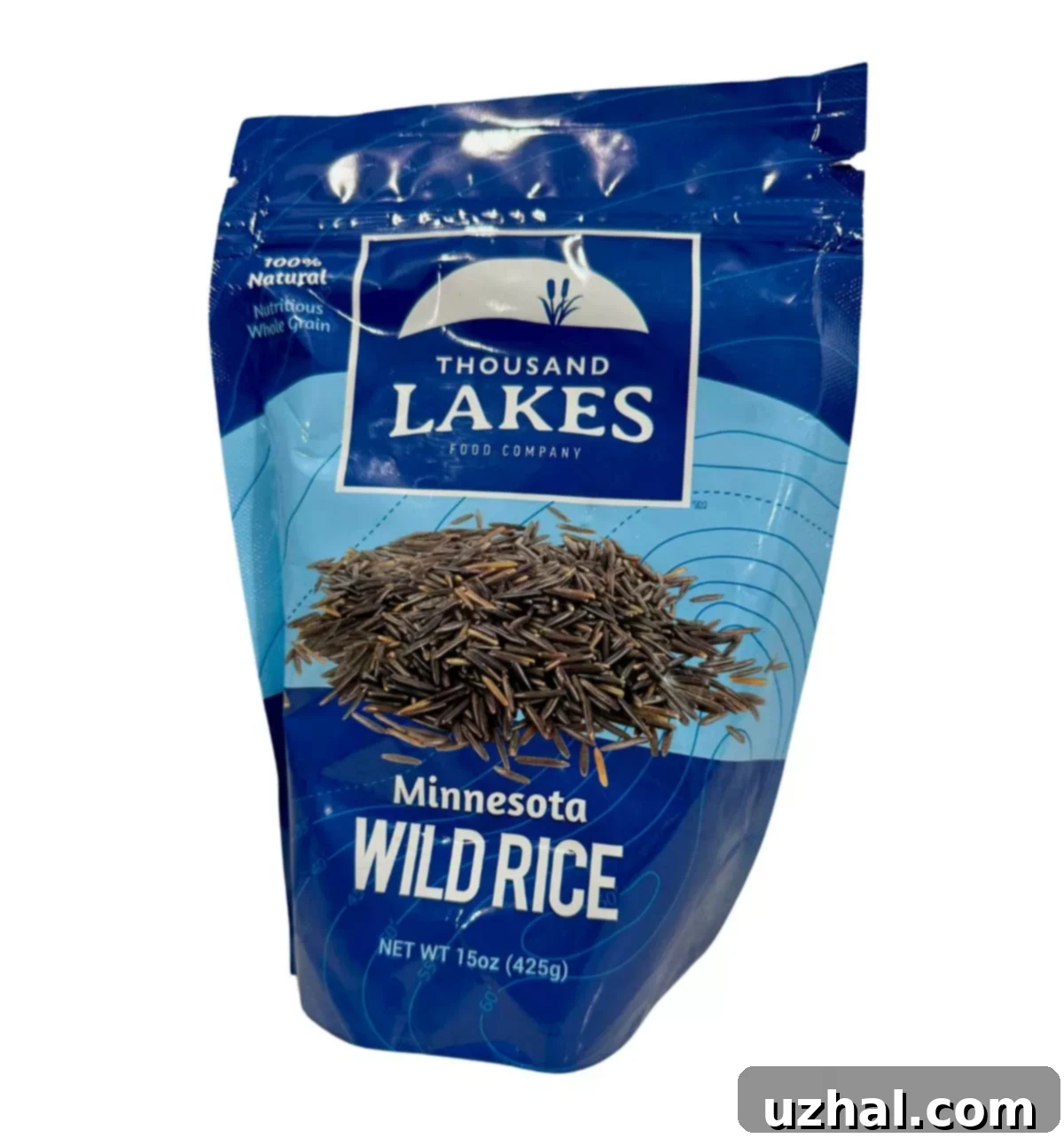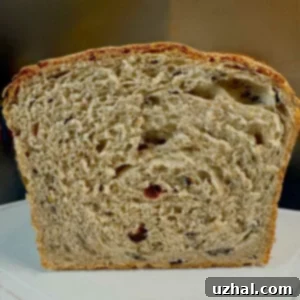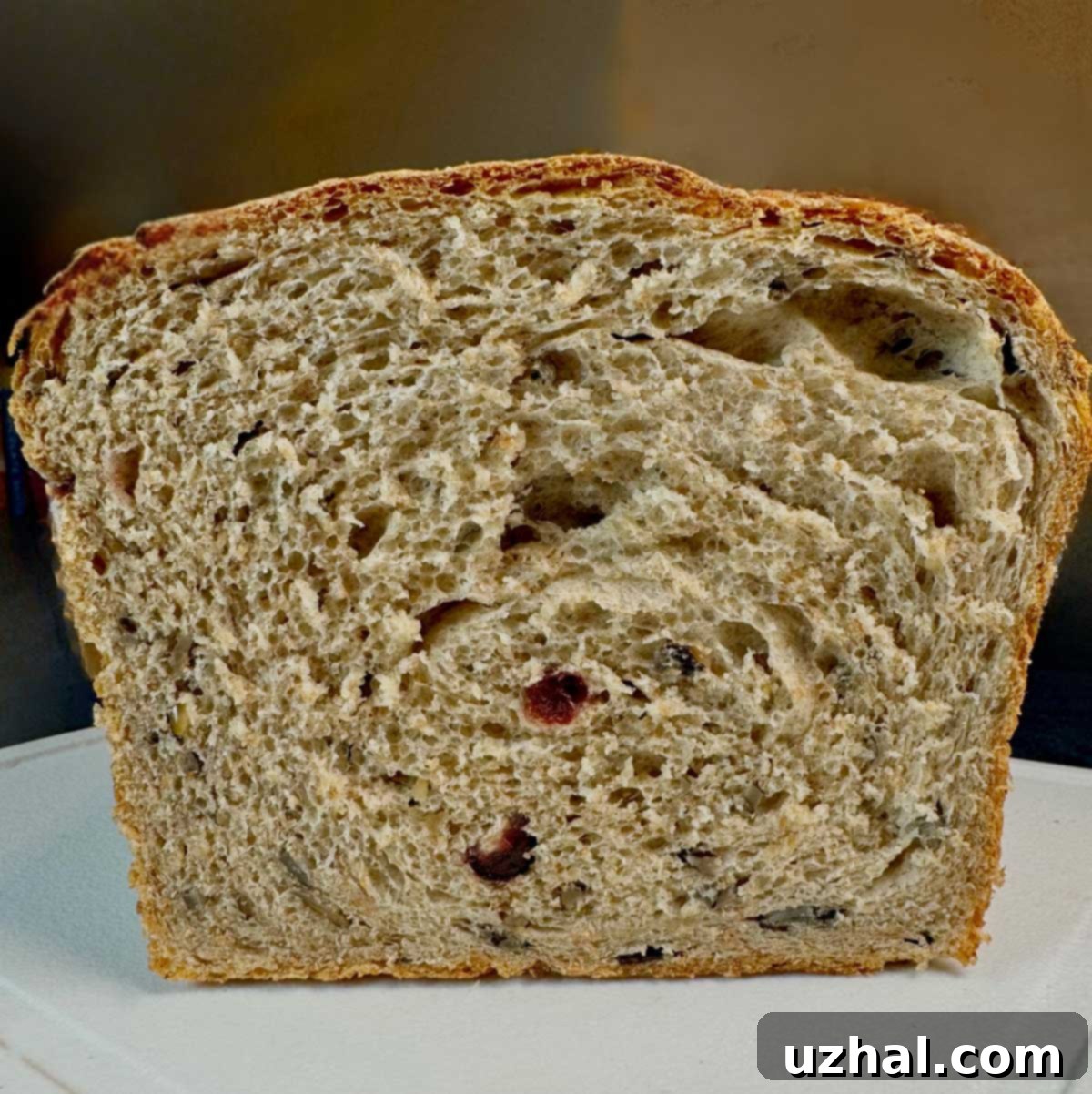Discover the Irresistible Flavor of Wild Rice Cranberry Bread: Your New Favorite Multi-Grain Sandwich Loaf
Embark on a culinary journey inspired by the rich traditions of Madeline Island, Wisconsin, and the expansive Minnesota region with this delightful Wild Rice Cranberry Bread. This unique sandwich bread recipe, first brought to my attention by Sue, sent me down a fascinating rabbit hole into the historical significance of wild rice. I learned about the indigenous Chippewa people, who revered wild rice as “Manoomin” or “food that grows on the water,” a vital and sacred staple in their diet. This deep connection to the land and its bounties sparked the inspiration for this recipe, transforming a traditional grain into a modern culinary delight.
The result is a wonderfully soft and flavorful sandwich bread, a harmonious blend of white, whole wheat, and rye flours, generously studded with tender wild rice and sweet, dried cranberries. Its robust yet subtle flavor profile makes it the quintessential bread for an array of sandwiches, especially a classic turkey sandwich, where its texture and taste truly shine. This bread isn’t just a recipe; it’s a taste of American heritage, bringing together diverse ingredients in a comforting and incredibly satisfying loaf.
Jump to Recipe

Choosing the Perfect Wild Rice for Your Bread
When it came to crafting this bread, the selection of wild rice was paramount. While numerous recipes exist for wild rice breads, I chose to adapt a beloved cooked white rice bread recipe, scaling it up and enriching it with the wholesome goodness of wheat and rye flours. The real challenge, however, lay in substituting white rice with wild rice. My initial attempt using a “Lundberg Wild Rice Blend” yielded unsatisfactory results; the smaller, tougher bits within the blend created an unpleasantly crunchy texture that detracted from the bread’s desired softness.
This experience highlighted the importance of using pure, high-quality wild rice. After further experimentation, I discovered a superior option: wild rice sourced directly from Minnesota, specifically the Thousand Lakes brand. This wild rice consistently produced a beautifully integrated texture, adding its distinctive chewiness without any harsh crunchiness. The difference was truly transformative, proving that the type of wild rice profoundly impacts the final product. Opting for a pure wild rice ensures that rich, earthy flavor and characteristic bite that makes this bread so special, honoring the tradition of “food that grows on the water” in every slice.

Achieving the Ideal Wild Rice Bread Texture and Flavor
This Wild Rice Cranberry Bread delivers a substantial, yet incredibly soft loaf, boasting a texture reminiscent of classic Roman Meal bread – a perfect canvas for your favorite sandwiches or a delightful piece of morning toast. Despite containing three tablespoons of sugar and dried cranberries, this bread maintains a savory character rather than being overtly sweet. The cranberries provide a subtle burst of fruity sweetness that complements the earthy notes of the wild rice and the nutty flavors of the grains, without overwhelming the palate.
The cooked wild rice kernels impart a distinctive, satisfying chewiness to the crumb, which is a key characteristic of this bread. This isn’t just a textural addition; it contributes to a more engaging eating experience without being overly dense or challenging. Flavor-wise, the combination of whole wheat and rye flours creates a deep, complex taste that is wonderfully wholesome. Even with the inclusion of rye, the overall profile leans towards a rich, hearty whole wheat bread, making it broadly appealing. It’s a bread that feels both rustic and refined, with layers of flavor and a comforting, yielding texture that makes every bite a pleasure.
Ingredient Notes for Perfect Bread
Crafting the perfect loaf begins with understanding your ingredients. Here’s a detailed look at the components that make our Wild Rice Cranberry Bread truly exceptional:
- Wild Rice: The cornerstone of this recipe. It’s crucial to use a pure wild rice, not a blend. Blends often contain different types of rice or grains that can lead to an inconsistent texture, with hard, crunchy bits that disrupt the softness of the bread. My personal recommendation is Minnesota Lakes wild rice for its consistent quality and flavor, delivering the ideal chewy texture.
- Rye Flour: Dark rye flour is generally preferred for its deeper flavor and color, but any type of rye flour will work. Rye adds a wonderful, slightly tangy, and earthy note that complements the wild rice beautifully. It also contributes to the bread’s overall heartiness.
- Bread Flour: For this recipe, a high-protein bread flour is essential. I highly recommend King Arthur brand due to its superior protein content, which translates to robust gluten development. This extra gluten strength is vital for supporting the added weight and texture of the wild rice and cranberries, preventing the loaf from becoming dense or crumbly. While all-purpose flour can be used, it might result in a less airy texture. If using AP flour, consider adding a teaspoon or two of vital wheat gluten to boost its strength.
- Sugar: Regular granulated sugar works perfectly. However, for a subtle depth of flavor, you might consider substituting a portion of the sugar with honey. Honey not only sweetens but also adds moisture and a unique aromatic quality to the bread.
- Instant Yeast: My go-to is SAF Gold Label Instant Yeast. Instant yeast is fantastic because it doesn’t require proofing before mixing with other ingredients, saving time. Gold Label is particularly good for sweeter doughs, ensuring active fermentation. Always check the expiry date of your yeast to guarantee a good rise.
- Salt: Morton brand kosher salt is my preference. Salt is not just for flavor; it’s also crucial for controlling yeast activity and strengthening the gluten structure. If you typically bake with Diamond Crystal kosher salt, remember that it’s less dense than Morton’s, so you’ll need to use slightly more (about 1.5 times the amount) to achieve the same salinity.
- Whole Wheat Flour: I find Pillsbury or Gold Medal whole wheat flours to be ideal for this recipe. These brands tend to have finer, less “spiky” grains, which are gentler on gluten strands during kneading and more friendly to a dough hook. Some whole wheat flours, like King Arthur’s, while flavorful, can have sharper bran particles that may cut through gluten, potentially leading to denser loaves. To be safe, I often start kneading gently with the dough hook and finish kneading whole wheat dough by hand to ensure a smooth, elastic consistency without overworking the gluten.
- Unsalted Butter: Any brand of unsalted butter will do. The butter adds richness, tenderness, and flavor to the bread. Ensure it’s softened to room temperature for easier incorporation into the dough.
One of the many appealing aspects of this Wild Rice Cranberry Bread is its relatively quick preparation time. Unlike some artisanal breads, it doesn’t demand an overnight fermentation or the preparation of a pre-ferment (like a sponge or poolish), making it accessible for bakers with busier schedules. The process is straightforward, allowing you to enjoy a homemade loaf without extensive planning.
However, for the more adventurous bakers seeking to deepen the complexity of flavors and textures, experimenting with a touch of diastatic malt powder and an overnight cold fermentation could be a rewarding endeavor. Diastatic malt powder aids in sugar conversion for richer browning and a softer crumb, while a slow, cold rise develops more nuanced flavors in the dough. Even so, the recipe, as presented, is delicious and satisfying in its own right, delivering a wonderful loaf every time.
This recipe has been rigorously tested twice by me and once by my friend Sue, confirming its reliability and deliciousness. Its forgiving nature makes it amenable to various changes and variations, so I wholeheartedly encourage you to give it a try and perhaps even make it your own.
Serving Suggestions and Variations
While this Wild Rice Cranberry Bread is undeniably perfect for turkey sandwiches, its versatility extends far beyond. Imagine it as the base for a gourmet grilled cheese, where the cranberries offer a sweet counterpoint to savory cheeses. It’s also excellent toasted with butter and jam for breakfast, or alongside a bowl of hearty soup for a comforting meal. For an elevated experience, try it with cream cheese and a sprinkle of cinnamon for a delightful morning treat.
Feeling creative? Consider these variations:
- **Nutty Addition:** Add a quarter cup of chopped pecans or walnuts along with the cranberries for extra crunch and flavor.
- **Savory Twist:** Omit the cranberries and add a tablespoon of dried rosemary or thyme, along with a quarter cup of shredded Parmesan cheese, for a savory herb bread.
- **Sweet Spice:** Introduce a teaspoon of ground cinnamon or cardamom to the flour mixture for a subtly spiced bread that pairs wonderfully with coffee or tea.
No matter how you choose to enjoy or adapt it, this Wild Rice Cranberry Bread is designed to be a memorable and enjoyable baking project.
- Chips Gone Wild!
- Martha White Chocolate Strawberry Pie
- Hazelnut Lime Pepper Cookies
- Minnesota State Fair Cookies
- Chocolate Banana Brownies
Recipe

Wild Rice Cranberry Bread
Anna
Pin Recipe
Ingredients
- 1 cup cooked wild rice (Ensure it’s pure wild rice, not a blend, for the best texture)
- 2 cups bread flour plus another ¼ cup for the mat (280 grams plus 70 grams for mat; high-protein bread flour is recommended)
- ¾ cups rye flour (100 grams; dark rye for richer flavor, but any rye will work)
- 3 tablespoons sugar (Granulated sugar or honey for a different note)
- 1 tablespoon instant yeast (SAF gold label is highly recommended for reliable activation)
- 1 ½ cups very warm water (130 degrees F) (Crucial temperature for activating yeast without killing it)
- 1 cup whole wheat flour (130 grams; Pillsbury or Gold Medal for a less dense crumb)
- 2 teaspoons salt (Morton kosher; adjust if using Diamond Crystal)
- 3 tablespoons softened unsalted butter (Ensures a tender crumb and rich flavor)
- ⅓ cup dried cranberries, chopped (Provides bursts of sweet-tart flavor; chopping helps distribute them evenly)
Instructions
-
Thoroughly grease a 9×5 inch loaf pan. A slightly larger loaf pan would also be suitable for this generous dough, but it’s important not to go smaller than 9×5 inches without adjusting the dough quantity to prevent overflow. For example, if you have an 8 ½ by 4 ½ inch pan, you might make one main loaf and a small mini loaf from the excess dough. This careful greasing ensures easy release after baking.
-
In the bowl of a stand mixer, combine the cup of warm cooked wild rice, 2 cups of bread flour, ¾ cup of rye flour, the instant yeast, and sugar. Pour in the very warm water (ensure it’s around 130°F, as too hot will kill the yeast and too cold won’t activate it properly). Stir these ingredients by hand until they are just moistened and well blended. Next, add the salt and softened unsalted butter. Continue mixing by hand until these new additions are fully incorporated into the dough. Finally, stir in about half a cup of the whole wheat flour.
-
Attach the dough hook to your stand mixer and begin kneading the dough on a low speed. After the first minute or so, pause the mixer and use a spatula to scrape down any dough clinging to the sides of the bowl, ensuring even mixing. Continue gently kneading with the dough hook, gradually adding the remaining ½ cup of whole wheat flour a little at a time, stopping to scrape the bowl as needed. The primary goal at this stage is to initiate the gluten development process. The dough should still be slightly sticky to the touch when you’re ready to transfer it.
-
Lightly dust a clean pastry mat or work surface with a portion of the extra ¼ cup of bread flour. Transfer the slightly sticky dough onto this floured surface. Press the dough out into a flat, roughly rectangular shape. Evenly sprinkle the chopped dried cranberries across the surface of the dough. Now, begin the final kneading process by hand, working the cranberries into the dough as you go. Gradually incorporate all of the reserved ¼ cup of bread flour into the dough during this phase. Continue kneading by hand until the dough becomes smooth, elastic, and the cranberries are well distributed throughout. This hand-kneading ensures the perfect final texture and uniform cranberry distribution.
-
Lightly grease a large mixing bowl with oil. Place the kneaded dough into the greased bowl, turning it once or twice to lightly coat the entire surface with oil. This prevents the dough from drying out. Cover the bowl tightly with plastic wrap or a clean kitchen towel. Allow the dough to rise in a warm, draft-free place for approximately 1 hour, or until it has visibly doubled in size. This first rise is crucial for developing flavor and achieving a light, airy crumb.
-
Once the dough has doubled, gently turn it out onto your pastry mat. Lightly press the dough into a rectangle shape, then starting from one of the longer sides, gently roll it downward into a tight cylinder. As you roll, tuck in the corners and press out any air bubbles to create a smooth, even loaf. Give the cylinder a gentle bounce or two on the counter to help it settle into a uniform shape. Carefully transfer the shaped loaf into the prepared, greased loaf pan. Cover the pan loosely with greased plastic wrap (greasing prevents sticking) and let it rise for a second time, for another hour, or until it has nearly doubled in size again and looks puffy.
-
While your bread is undergoing its second rise, preheat your oven to 375 degrees F (190 degrees C). This ensures the oven is at the correct temperature when the bread is ready to bake, leading to a consistent rise and even baking.
-
Bake the bread for approximately 50 minutes. You’ll know it’s done when the crust is golden brown and a thermometer inserted into the center reads between 200-210 degrees F (93-99 degrees C). Once baked, remove the pan from the oven and let the bread cool in the pan for only 5 minutes. This brief cooling period helps the loaf firm up slightly. After 5 minutes, carefully turn the bread out onto a wire rack to cool completely. Cooling on a rack is crucial to prevent the bottom of the loaf from becoming soggy. Slice and enjoy once fully cooled.
